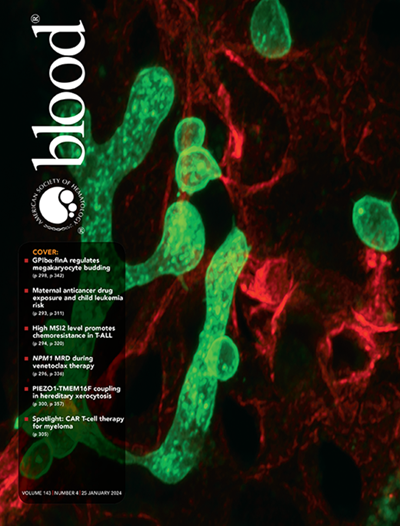Clinical Outcomes after Allogeneic Hematopoietic Stem Cell Transplantation in Patients with Transfusion-Dependent β-Thalassemia Treated at the Bambino Gesù Children's Hospital, Rome, Italy
IF 23.1
1区 医学
Q1 HEMATOLOGY
引用次数: 2
Abstract
β-thalassemia is one of the most common monogenic blood disorders worldwide, and is highly prevalent in Mediterranean countries. Allogeneic hematopoietic stem cell transplantation (allo-HSCT) has been the only curative treatment for transfusion-dependent β-thalassemia (TDT; the most severe disease form) for many years, but it is limited by donor availability and has a significant risk of morbidity and mortality. We conducted a chart review of patients with β-thalassemia who underwent allo-HSCT (N=80) at the Bambino Gesù Children's Hospital, Rome, Italy, between March 2011 and August 2018. Median (range) age at allo-HSCT was 5.5 (0.3-20.0) years [<12 years: n=70 (87.5%), ≥12-18 years: n=7 (8.8%), ≥18 years: n=3 (3.8%)] and all patients but one had TDT [n=79 (98.8%)]. Prior to allo-HSCT, patients received a median (range) of 17.4 (4-52) transfusions per year (n=64) and had a median (range) serum ferritin concentration of 1217 (135-9123) ng/mL and a median (interquartile range) hemoglobin level of 10.3 (9.3-11.4) g/dL. All patients had received regular iron chelation therapy prior to transplantation. In total, 18 (22.5%), 28 (35.0%), and 34 (42.5%) patients received allo-HSCT from human leukocyte antigen (HLA)-identical sibling donors, HLA-haploidentical donors, and unrelated donors (fully matched donor: n=28, donor with a single HLA disparity: n=6), respectively. Of these donors, 42 (52.5%) were carriers for thalassemia-associated mutations. In total, 53 (66.3%) donors and 35 (43.8%) recipients were cytomegalovirus-positive. Bone marrow was the stem cell source in 51 cases (63.8%), while 28 patients received an alphabeta T-cell depleted peripheral blood haploidentical HSCT (35.0%); the remaining child (1.3%) received both bone marrow and cord blood from the same related donor. All patients continued to receive transfusions immediately after allo-HSCT; however, only 7 (8.8%) received a transfusion in the 3 to 12-month post-transplantation period (2 due to underlying disease; 5 due to other reasons including GI bleeding). Median (range) time to reach transfusion-free status was 3.8 (1.1-47.8) weeks. Median (interquartile range) hemoglobin levels at 6 and 12 months after allo-HSCT were 10.9 (10.2-11.9) and 11.9 (10.6-13.0) g/dL, respectively. The cumulative incidences of primary and secondary graft failure were 10.0% and 12.5% at 24 months (HLA-identical donor: 0% and 11.1%, haploidentical donor: 17.9% and 3.6%, unrelated donor: 8.8% and 20.6%). Eleven out of 14 patients experiencing graft failure were successfully rescued with a second allograft, while 2 patients were not retransplanted due to parental decision and 1 patient died after the engraftment of the second allograft. Eight patients developed grade II-IV acute graft-versus-host disease (GVHD) and one patient developed moderate chronic GVHD. Cumulative incidence rates of grades II-IV and III-IV acute GVHD were 12.7% and 8.0% at 24 months (HLA-identical donor: 0% and 0%, haploidentical donor: 7.3% and 0%, unrelated donor: 23.8% and 18.8%). Three patients (3.8%) died of transplant-related causes (1 case each of hemophagocytic lymphohistiocytosis, sepsis, and multi-organ failure [the patient receiving the second allograft]) with a median (range) time from transplantation to death of 8.7 (3.7-11.0) months. Of these patients, all had been transplanted from an unrelated donor and 2 had reached sustained full-donor chimerism. The probability of overall and event-free (event defined as either death or primary/secondary graft failure) survival was 96.2% and 81.2% at 24 months (HLA-identical sibling donor: 100% and 88.9%, haploidentical donor: 100% and 78.6%, unrelated donor: 91.2% and 79.4%). The probability of thalassemia-free survival (event defined as either death or primary/secondary graft failure not rescued by a second allograft) was 93.7% at 24 months (HLA-identical sibling donor: 100%, haploidentical donor: 92.9%, unrelated donor: 91.2%). In this large single-center cohort of children with predominantly TDT, allo-HSCT led to beneficial outcomes for most patients, resulting in the discontinuation of transfusions with 93.7% of patients being thalassemia-free. Nevertheless, HSCT is still associated with GVHD, graft failure, and mortality, and only 22.5% of patients had an HLA-identical sibling donor, illustrating a key limitation of allo-HSCT. Emerging research is addressing such barriers to treatment. Merli: Novartis: Honoraria; Sobi: Consultancy; Amgen: Honoraria; Bellicum: Consultancy. Algeri:Miltenyi: Honoraria; Atara Biotherapeutics: Consultancy, Honoraria; Bluebird bio: Consultancy, Honoraria. Gruppioni:Bluebird bio: Employment, Equity Ownership. Kommera:Bluebird bio: Employment, Equity Ownership. Maa:Bluebird bio: Employment, Equity Ownership. Locatelli:Bellicum: Consultancy, Membership on an entity's Board of Directors or advisory committees; Novartis: Consultancy, Membership on an entity's Board of Directors or advisory committees; bluebird bio: Consultancy; Amgen: Honoraria, Membership on an entity's Board of Directors or advisory committees; Miltenyi: Honoraria.在Bambino儿童医院Gesù治疗输血依赖性β-地中海贫血患者的异体造血干细胞移植后的临床结果
β-地中海贫血是世界上最常见的单基因血液疾病之一,在地中海国家非常普遍。同种异体造血干细胞移植(allo-HSCT)一直是治疗输血依赖性β-地中海贫血(TDT;这是多年来最严重的疾病形式,但它受到供体供应的限制,并且有很大的发病率和死亡率风险。我们对2011年3月至2018年8月期间在意大利罗马Bambino Gesù儿童医院接受同种异体造血干细胞移植的β-地中海贫血患者(N=80)进行了图表回顾。异位hsct患者的中位(范围)年龄为5.5(0.3-20.0)岁[<12岁:n=70(87.5%),≥12-18岁:n=7(8.8%),≥18岁:n=3(3.8%)],除1例患者外,所有患者均有TDT [n=79(98.8%)]。在进行同种异体造血干细胞移植之前,患者每年接受17.4(4-52)次输血(n=64),血清铁蛋白浓度中位数(范围)为1217 (135-9123)ng/mL,血红蛋白水平中位数(四分位数范围)为10.3 (9.3-11.4)g/dL。所有患者在移植前均接受常规铁螯合治疗。总共有18例(22.5%)、28例(35.0%)和34例(42.5%)患者接受了来自人类白细胞抗原(HLA)相同的兄弟姐妹供者、HLA-单倍相同供者和非亲属供者(完全匹配供者:n=28, HLA差异单一的供者:n=6)的同种异体造血干细胞移植。在这些献血者中,42人(52.5%)携带地中海贫血相关突变。供者53例(66.3%),受者35例(43.8%)巨细胞病毒阳性。51例(63.8%)患者以骨髓为干细胞来源,28例(35.0%)患者接受了α t细胞耗尽的外周血单倍同型造血干细胞移植;其余儿童(1.3%)接受了来自同一亲属供者的骨髓和脐带血。所有患者在同种异体造血干细胞移植后立即继续接受输血;然而,只有7例(8.8%)在移植后3 - 12个月接受了输血(2例由于潜在疾病;5 .其他原因(包括消化道出血)。达到无输血状态的中位(范围)时间为3.8(1.1-47.8)周。同种异体造血干细胞移植后6个月和12个月的血红蛋白水平中位数(四分位数范围)分别为10.9(10.2-11.9)和11.9 (10.6-13.0)g/dL。在24个月时,原发性和继发性移植失败的累积发生率分别为10.0%和12.5% (hla相同供者:0%和11.1%,单倍相同供者:17.9%和3.6%,非亲属供者:8.8%和20.6%)。14例移植失败的患者中有11例通过第二次移植成功获救,2例患者由于父母的决定而没有再次移植,1例患者在第二次移植后死亡。8例患者发展为II-IV级急性移植物抗宿主病(GVHD), 1例患者发展为中度慢性移植物抗宿主病。在24个月时,II-IV级和III-IV级急性GVHD的累积发病率分别为12.7%和8.0% (hla相同供者:0%和0%,单倍相同供者:7.3%和0%,非亲属供者:23.8%和18.8%)。3例(3.8%)患者死于移植相关原因(噬血细胞性淋巴组织细胞增多症、败血症和多器官功能衰竭各1例[接受第二次同种异体移植的患者]),从移植到死亡的中位(范围)时间为8.7(3.7-11.0)个月。在这些患者中,所有患者都是从一个不相关的供体移植的,其中2例达到了持续的全供体嵌合。总生存率和无事件生存率(事件定义为死亡或原发性/继发性移植物失败)在24个月时分别为96.2%和81.2% (hla相同的兄弟姐妹供体:100%和88.9%,单倍体相同供体:100%和78.6%,非亲属供体:91.2%和79.4%)。无地中海贫血生存率(事件定义为死亡或原发性/继发性移植物失败,未被第二次同种异体移植物挽救)在24个月时的概率为93.7% (hla相同的兄弟姐妹供体:100%,单倍体相同供体:92.9%,非亲属供体:91.2%)。在这个以TDT为主的大型单中心儿童队列中,对大多数患者来说,同种异体造血干细胞移植带来了有益的结果,导致93.7%的无地中海贫血患者停止输血。然而,HSCT仍然与GVHD、移植物失败和死亡率相关,只有22.5%的患者有相同的hla同胞供体,这说明了同种异体HSCT的一个关键限制。新兴研究正在解决这些治疗障碍。梅里:诺华:荣誉;艺人:咨询公司;安进:谢礼;Bellicum:咨询公司。身上:Miltenyi:谢礼;Atara Biotherapeutics:咨询公司;蓝鸟简历:咨询公司。Gruppioni:蓝鸟生物:就业,股权。Kommera:蓝鸟简历:就业,股权。Maa:蓝鸟简历:就业,股权。 Locatelli:Bellicum:顾问,实体董事会或咨询委员会成员;诺华:顾问,实体董事会或咨询委员会成员;蓝鸟生物:咨询;安进:名誉、实体董事会或咨询委员会成员;Miltenyi:谢礼。
本文章由计算机程序翻译,如有差异,请以英文原文为准。
求助全文
约1分钟内获得全文
求助全文
来源期刊

Blood
医学-血液学
CiteScore
23.60
自引率
3.90%
发文量
955
审稿时长
1 months
期刊介绍:
Blood, the official journal of the American Society of Hematology, published online and in print, provides an international forum for the publication of original articles describing basic laboratory, translational, and clinical investigations in hematology. Primary research articles will be published under the following scientific categories: Clinical Trials and Observations; Gene Therapy; Hematopoiesis and Stem Cells; Immunobiology and Immunotherapy scope; Myeloid Neoplasia; Lymphoid Neoplasia; Phagocytes, Granulocytes and Myelopoiesis; Platelets and Thrombopoiesis; Red Cells, Iron and Erythropoiesis; Thrombosis and Hemostasis; Transfusion Medicine; Transplantation; and Vascular Biology. Papers can be listed under more than one category as appropriate.
 求助内容:
求助内容: 应助结果提醒方式:
应助结果提醒方式:


